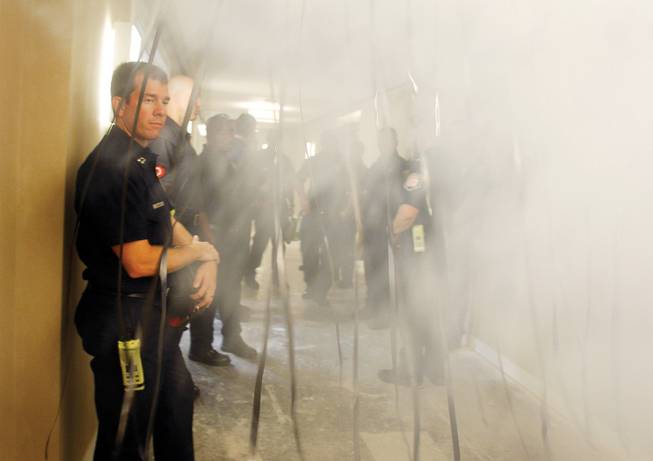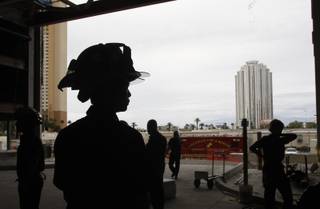
Las Vegas Fire Capt. Brian Gray watches theatrical smoke being used for a ventilation demonstration during a walk-through last Monday for a multi-agency training exercise at the Fontainebleau. Firefighters from all Las Vegas Valley departments will take part in the drills.
Monday, Oct. 19, 2009 | 2 a.m.
Fontainebleau
Sun Coverage
Sun History Project
Sun Archives
- Fontainebleau president among execs leaving project (10-15-2009)
- Fontainebleau a symbol of bad timing, not the only victim (10-12-2009)
- Fontainebleau judge wants quick sale of bankrupt project (10-2-2009)
- In reversal, Fontainebleau lenders suggest liquidation (9-25-2009)
- Fontainebleau: Bank no longer ‘seeking to destroy’ project (9-17-2009)
Beyond the Sun
In the next month, the wrecked economy will deliver an important public safety benefit: Las Vegas Valley firefighters will get a chance to train for one of the city’s worst nightmares, a high-rise hotel fire. And they’ll do in it in a real but unfinished high rise, the stalled Fontainebleau.
Most years, the valley’s four fire departments — North Las Vegas, Las Vegas, Henderson and Clark County — conduct drills at local resorts, said Las Vegas Fire & Rescue Capt. Brian Gray, who is organizing this year’s drills. And this year has a bit of that, too, with a reenactment in early October of a fire at Texas Station as it would sound over the dispatch radio.
Gray said the Fontainebleau is a unique opportunity to not only train for multiple days inside a large property without disrupting and trying to work around staff and customers but also to tour an unfinished property and see how a modern megaresort is built — how the walls are built, what materials are used inside elevator shafts, how far above casino floors sprinklers are mounted — information that could save the lives of tourists and firefighters.
“We can’t thank Fontainebleau management enough for this opportunity,” Gray said.
Preparing for the drills took three months, Gray said. The largest challenge is to arrange training dates and times that would allow every firefighter in the valley to attend, barring illness or vacation. The training will culminate in a full-scale simulated fire in early November, the details of which will not be known in advance by the firefighters. The first training was a walk through of the property last Monday, a chance for the firefighters to reacquaint themselves with the tasks of high-rise firefighting before the major drill.
“It’s not our typical house fire, which we’re very good at. But we find that when we’re trying to respond to high-rise fires, we’re treating them like they’re regular houses, which doesn’t work,” Gray said.
Among the differences, Gray said, are long hallways and tall flights of stairs, the last one being an especially brutal concern for the first firefighters to arrive, since the multiagency plan for high-rise fires says that before reinforcements arrive and secure the elevators, all firefighters must take the stairs and carry their equipment up with them.
Another challenge firefighters will face is that all four fire departments use slightly different equipment and radio lingo. The unified command that plans for high-rise fires is standardizing the radio etiquette, but for the foreseeable future there will still be minor differences in hose types and spray nozzles. One of the uses of these training exercises is to familiarize firefighters with their counterparts’ equipment.
Beyond dousing flames, the main challenges of fighting high-rise fires are managing the arrival of new fire crews outside the hotel, cordoning off and controlling the lobby so tourists and staff can be evacuated and firefighters can get in, finding engineers and security staff who can explain the property and give firefighters control of the service elevators (which go to all floors and have higher carrying capacities than passenger elevators), figuring out a way to ventilate the smoke and establishing a post two floors below the fire to rotate firefighters, rest them, give them water to drink and fresh bottles of air to breathe. Of these tasks, one of the least intuitive is how to remove the smoke.
It is also one of the most important.
Fire maims and scars, but smoke suffocates and kills many more people, says one of the trainers, Las Vegas Fire & Rescue Capt. Brad Hannig. At a house fire, the standard solution, often even before firefighters go into a building, is to break out windows. High rise windows, however, are too hard to break, have a long way to fall if you do break them and might even make matters worse once broken by providing a channel for wind to feed the fire.
The best solution is to pressurize the building’s stairwells with high-powered portable fans so that air moves up the stairwell on one side, reaches the floor of the fire and pushes smoke down the hallway, up the stairwell on the other end and out through the roof.
The hotels have ventilation and duct systems that are designed to suppress a fire, but they can’t be the first line of attack, Hannig said.
“We’re not saying that they won’t work, they just won’t work like firemen want them to work,” Hannig said.
“The propeller-heads designed them to work eventually. We want them to work now.”


Join the Discussion:
Check this out for a full explanation of our conversion to the LiveFyre commenting system and instructions on how to sign up for an account.
Full comments policy